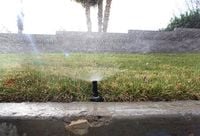Arizona is facing a potential crisis regarding its water resources, as a proposed rule by the Environmental Protection Agency (EPA) threatens to complicate the already delicate relationship the state has with its water supply. This situation follows a significant legal shift two years ago when the Supreme Court narrowed the definition of waters that receive federal protection, a move that has raised alarms among various stakeholders in Arizona.
On April 30, 2025, KAWC reported that the proposed EPA rule could further complicate Arizona's water resources. The Supreme Court's decision in 2023 determined that only wetlands physically connected to other federally recognized waters would qualify for federal protection. This ruling has left many in Arizona concerned about the implications for the state's water quality and availability.
Elise Ketcham, communications director for the Arizona Wildlife Federation, voiced her concerns regarding the proposed changes. "The proposal would jeopardize the state's water quality and disproportionately impact ephemeral streams," she stated. Ketcham explained that Arizona lacks state protections for these streams, which are crucial to the ecosystem. Most of Arizona's streams are ephemeral, meaning they only run after rainfall or snowmelt, and without federal protections, these waterways could be at risk.
In Arizona, ephemeral streams are vital, as they contribute significantly to the overall water flow in the region. Ketcham noted that Arizona's seasonal streams provide about 85% of the water flow into the Gila River, a tributary of the Colorado River. Furthermore, these streams contribute approximately 75% of the water flow for the Salt River and Lake Mead, which is critical for providing drinking water to Arizonans.
"Lake Mead is a little bit more important for providing drinking water for Arizonans," Ketcham emphasized, highlighting the interconnectedness of the state's water systems. The Salt River and the Gila River support over 800 native wildlife species in Arizona, showcasing the ecological importance of maintaining healthy waterways.
This week, government agencies and Native tribes are holding listening sessions to discuss the implications of the proposed EPA rule. Experts fear that reducing regulatory burdens on industries could lead to increased pollution and debris in waterways, further endangering the delicate ecosystems that rely on clean water.
As the debate continues, Ketcham encourages voters to educate themselves about the potential impacts of these decisions. "Whether they are going out and fishing and the stream isn't being protected anymore that they have fished in for years, or if it is going to affect their drinking water," she outlined, emphasizing the broader implications for Arizonans.
Meanwhile, in Southern Nevada, officials are grappling with rising water use figures in the Las Vegas area. On the same day, the Las Vegas Review-Journal reported a 6% increase in water use compared to the previous year, translating to an additional 2.2 billion gallons of water consumed. With Lake Mead only 33% full, water managers are urging residents to take control of their lawn care practices to mitigate water use.
Bronson Mack, a spokesman for the Southern Nevada Water Authority, stated, "The uptick in water use this year emphasizes the importance of following the seasonal water restrictions for grass irrigation, as well as the SNWA’s recommended schedule for drip-irrigated trees and plants." He highlighted that during the summer months, Southern Nevadans can water their lawns up to six days a week, but watering is prohibited from 11 a.m. to 7 p.m. to prevent losses due to heat and high winds.
Sunday is designated as a no-watering day, regardless of the season, and residents who violate these rules could face fines for water waste if reported to the water authority. The punitive fee structure of “excessive use charges” remains in effect, meaning that customers of the Las Vegas Valley Water District could incur additional charges if they exceed their water usage limits.
To help manage water consumption, officials recommend that sprinklers run for a maximum of 12 minutes per watering day, divided into three cycles of four minutes each, spaced one hour apart. Mack advised that it is a good practice to run drip irrigation two or three days per week through May, and to gradually increase watering as temperatures rise from June to August, to keep landscapes healthy while managing monthly water bills.
The situation in both Arizona and Nevada underscores the urgent need for effective water management strategies in the face of dwindling resources. As climate change continues to impact water availability, the importance of responsible water use and conservation practices cannot be overstated. Residents in both states are urged to stay informed and engaged in discussions regarding water policy to ensure a sustainable future for their communities.




